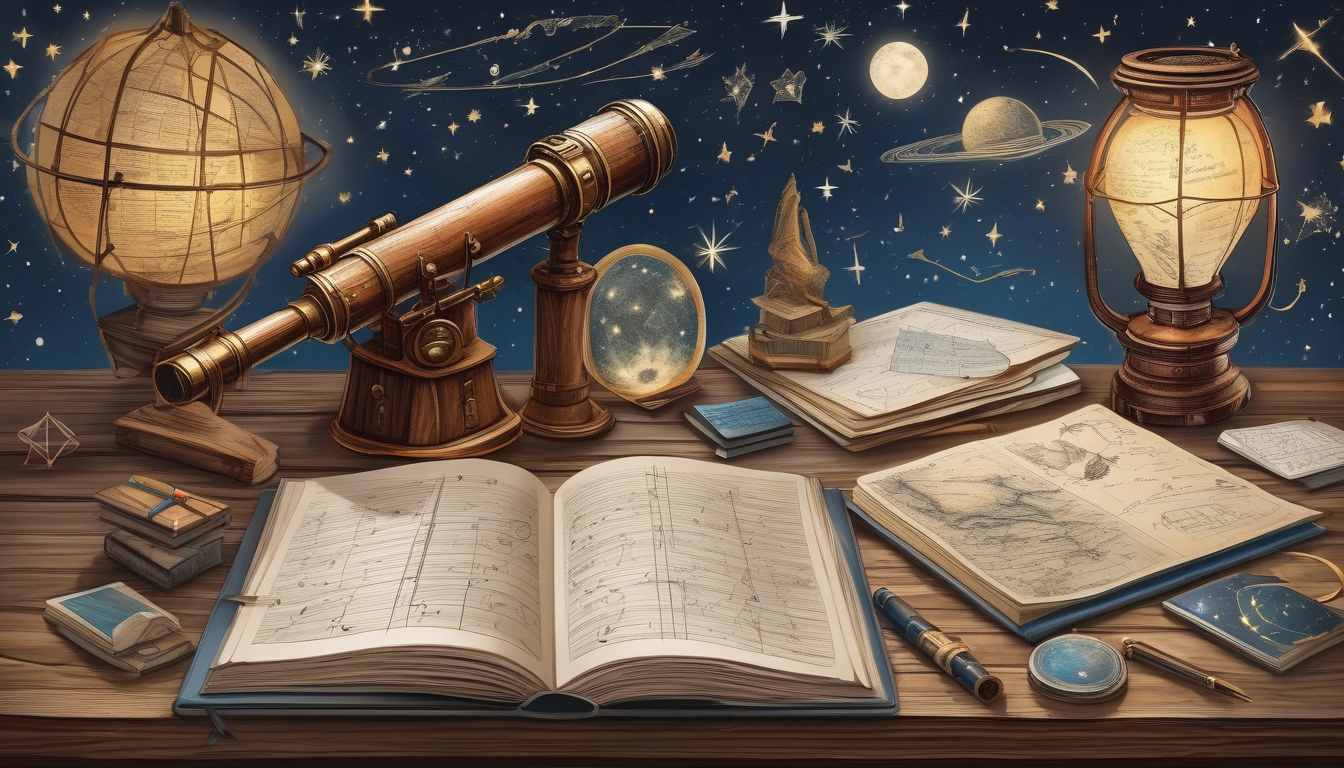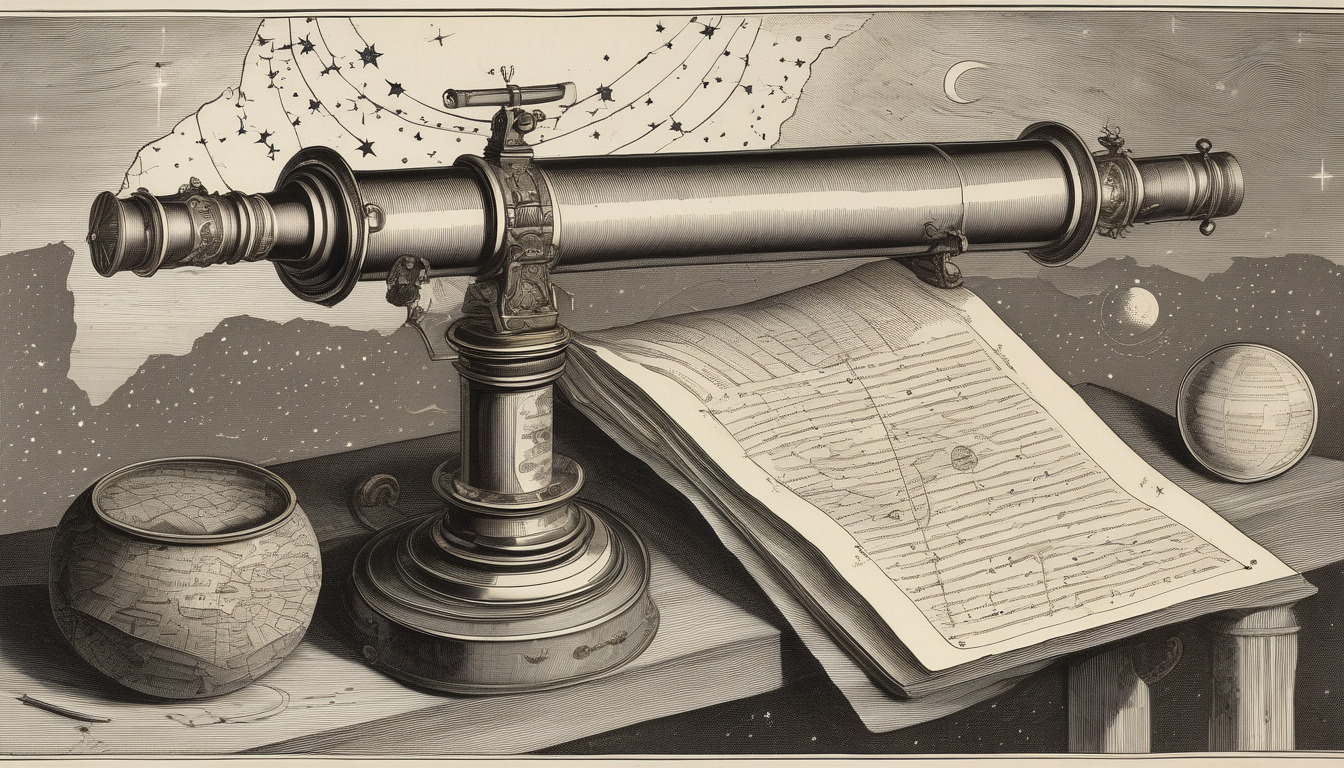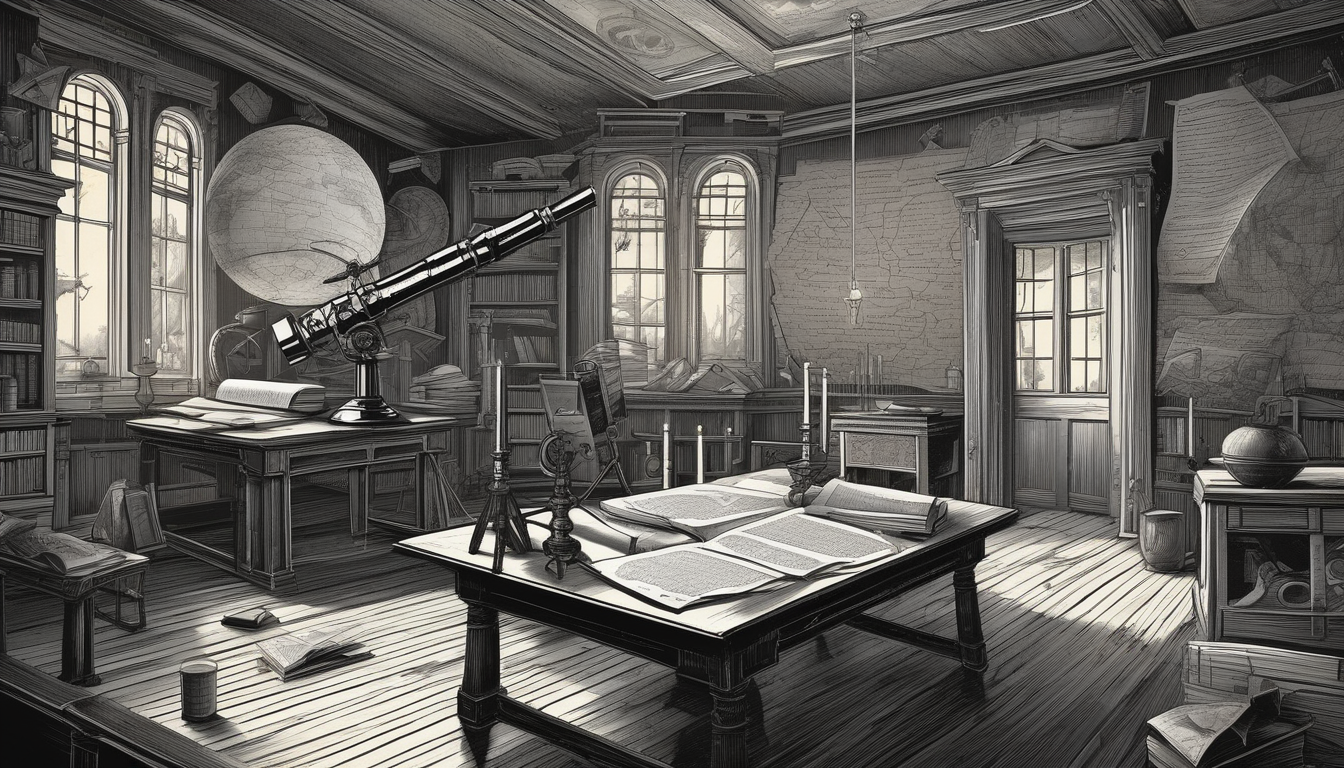When we think about the universe, our minds often drift to the vastness of space, the twinkling stars, and the mysteries that lie beyond our planet. Galileo Galilei, an Italian polymath, revolutionized our understanding of the cosmos with a simple yet powerful invention: the telescope. This article explores how Galileo’s innovative use of the telescope not only changed the course of astronomy but also challenged the very fabric of societal beliefs during his time.
The invention of the telescope in the early 17th century marked a monumental leap in observational astronomy. While the device itself was not initially created by Galileo, he perfected its design, allowing for unprecedented magnification of celestial bodies. Imagine looking at the night sky and suddenly being able to see the craters of the moon or the rings of Saturn! This new perspective opened up a world of possibilities, enabling astronomers to observe details that were previously invisible to the naked eye.
Galileo’s observations of celestial bodies were nothing short of astonishing. With his enhanced telescope, he discovered the moons of Jupiter, which he named the Medicean Stars in honor of his patrons. These moons—Io, Europa, Ganymede, and Callisto—provided concrete evidence that not everything revolved around the Earth, directly challenging the long-held geocentric model that placed our planet at the center of the universe. This discovery was pivotal, as it shifted the understanding of celestial motion and laid the groundwork for modern astronomy.
Moreover, Galileo’s observations of the phases of Venus further supported the heliocentric model proposed by Copernicus. By documenting how Venus appeared in various phases, much like the moon, Galileo provided evidence that Venus orbited the Sun, not the Earth. This was a game-changer! It was as if he had pulled back the curtain on the universe, revealing a complex dance of celestial bodies that defied conventional wisdom.
Galileo’s findings ignited a fierce debate within the scientific community and society at large. While many embraced his revolutionary ideas, others resisted, clinging to the familiar geocentric views. This clash of perspectives not only influenced the scientific discourse of his time but also set the stage for future conflicts between science and religion, particularly with the Catholic Church, which viewed Galileo’s work as a direct challenge to its authority.

The Invention of the Telescope
The invention of the telescope in the early 17th century was nothing short of revolutionary. Imagine a tool that could extend your vision beyond the horizon, allowing you to gaze into the cosmos as if it were just a stone’s throw away. The initial designs of the telescope were relatively simple, consisting of a convex lens and a concave lens, but they opened up a new realm of possibilities for astronomers. These early prototypes, often made by artisans and craftsmen, laid the groundwork for what would become one of the most significant instruments in the history of science.
Before Galileo, telescopes were primarily used for military purposes and terrestrial observations. However, Galileo Galilei saw the potential to use this groundbreaking invention for astronomy. In 1609, he crafted his own version of the telescope, significantly improving its magnifying power. With a telescope capable of magnifying objects up to 20 times, he was ready to challenge the status quo of astronomical knowledge.
Galileo’s enhancements to the telescope included a longer focal length and larger lenses, which allowed for clearer and more detailed observations. This was a game-changer; it was like upgrading from a black-and-white TV to a high-definition color screen. The clarity of the images he captured revealed celestial bodies in ways that had never been seen before.
To put it in perspective, consider the following table that highlights the key advancements in telescope technology:
| Year | Inventor | Key Features |
|---|---|---|
| 1608 | Hans Lippershey | First patent for a telescope; basic magnification |
| 1609 | Galileo Galilei | Improved design; up to 20x magnification |
| 1611 | Johannes Kepler | Introduced the Keplerian telescope; better field of view |
Through his use of the telescope, Galileo not only transformed our understanding of the universe but also ignited a scientific revolution that would change the course of history. His work with the telescope paved the way for future astronomers and set the stage for an era of exploration that continues to this day. The telescope was not just an instrument; it was a portal to the stars, shifting the very foundations of how humanity perceives its place in the universe.

Galileo’s Observations of Celestial Bodies
When Galileo turned his telescope towards the night sky, he unlocked a treasure trove of celestial wonders that had remained hidden from human eyes for centuries. His observations were nothing short of revolutionary, challenging the very fabric of our understanding of the universe. Imagine peering through a window into space and discovering moons dancing around Jupiter or the phases of Venus shifting like the changing tides. These revelations not only amazed Galileo but also sent shockwaves through the scientific community and society at large.
One of Galileo’s most significant findings was the discovery of the four largest moons of Jupiter, which he aptly named the “Medicean Stars” in honor of his patrons. This was a monumental moment in astronomy, as it provided concrete evidence that not everything revolved around the Earth—a cornerstone of the geocentric model. The moons he observed—Io, Europa, Ganymede, and Callisto—were the first celestial bodies to be discovered orbiting another planet, which fundamentally shifted the paradigm of celestial motion.
Galileo’s observations of these moons were groundbreaking. By documenting their movements over several nights, he provided visual proof that celestial bodies could orbit something other than the Earth. This was a direct challenge to the prevailing geocentric theory, which held that all heavenly bodies revolved around our planet. The implications of this discovery were immense, as it not only supported the heliocentric model proposed by Copernicus but also laid the groundwork for future astronomical research.
The impact of Galileo’s findings on geocentrism was profound. The scientific community was forced to confront a new reality, one where the Earth was not the center of the universe. Such a shift was met with resistance from many quarters, particularly from those who held steadfast to traditional beliefs. Galileo’s work ignited debates that would last for decades, forever altering the course of astronomy.
Moreover, his observations of the phases of Venus further solidified the heliocentric model. By demonstrating that Venus exhibited phases similar to the Moon, Galileo provided additional evidence that it orbited the Sun, not the Earth. This was a critical turning point, as it offered a clear contradiction to the geocentric view and bolstered the acceptance of heliocentrism among astronomers.
In summary, Galileo’s observations of celestial bodies were not just scientific achievements; they were a catalyst for a broader cultural shift. They challenged long-held beliefs, ignited fierce debates, and ultimately paved the way for a new era in astronomy. As we look up at the night sky today, we owe much to Galileo’s pioneering spirit and insatiable curiosity.
The Moons of Jupiter
Galileo’s discovery of Jupiter’s four largest moons—Io, Europa, Ganymede, and Callisto—was nothing short of revolutionary. These celestial bodies, now known as the Galilean moons, were the first objects found to be orbiting another planet, which provided compelling evidence against the long-held geocentric model of the universe. Imagine looking through a telescope and realizing that not everything revolves around Earth; it was like opening a door to a whole new cosmos!
Before Galileo’s observations, the prevailing belief was that all celestial bodies revolved around the Earth. However, as he meticulously recorded his findings, he noticed that these moons exhibited a consistent pattern of movement around Jupiter. This was a game changer! The implications of these observations were profound, as they suggested that not all heavenly bodies followed the Earth-centered model. To illustrate this point, here’s a quick table summarizing the Galilean moons:
| Moon | Diameter (km) | Orbital Period (days) |
|---|---|---|
| Io | 3,643 | 1.8 |
| Europa | 3,121 | 3.5 |
| Ganymede | 5,268 | 7.2 |
| Callisto | 4,821 | 16.7 |
These moons not only challenged the geocentric view but also sparked curiosity and debate among astronomers and philosophers of the time. Galileo’s observations were crucial in shifting the narrative from Earth-centric to a more expansive understanding of our solar system. Can you imagine the excitement and fear that such revelations must have instilled in a society that had held onto its beliefs for centuries?
In the grand tapestry of astronomy, Galileo’s observations of Jupiter’s moons were like the first brush strokes on a blank canvas, setting the stage for future exploration and discovery. His work laid the groundwork for astronomers like Kepler and Newton, who would further unravel the mysteries of the universe. The Galilean moons continue to be a focal point of study, as they hold clues to the origins of our solar system and the potential for life beyond Earth.
Impact on Geocentrism
Galileo’s discoveries were nothing short of revolutionary, shaking the very foundations of the geocentric model that had dominated astronomy for centuries. Before Galileo, the prevailing belief, supported by the likes of Ptolemy, was that the Earth stood still at the center of the universe, with all celestial bodies revolving around it. However, when Galileo pointed his telescope toward the heavens, he began to unravel this long-held notion.
His observations of Jupiter’s four largest moons—Io, Europa, Ganymede, and Callisto—were particularly groundbreaking. These moons, which he dubbed the “Medicean Stars,” showcased celestial bodies orbiting another planet, providing compelling evidence that not everything revolved around the Earth. This was a direct challenge to the geocentric model, as it suggested that the Earth was not the center of all things, but merely one of many bodies in a vast universe.
Furthermore, Galileo’s observations of the phases of Venus presented another nail in the coffin for geocentrism. He noted that Venus exhibited a full set of phases, much like the Moon. This phenomenon could only be explained if Venus orbited the Sun, supporting the heliocentric model proposed by Copernicus. To many in the scientific community, this evidence was irrefutable, yet it stirred up heated debates among scholars and theologians alike.
The implications of Galileo’s findings were profound:
- Shift in Paradigm: The transition from a geocentric to a heliocentric understanding of the universe marked a pivotal moment in scientific thought.
- Scientific Debate: His work ignited discussions that would eventually lead to the Scientific Revolution, where empirical evidence began to take precedence over accepted dogma.
- Societal Impact: As people began to question traditional beliefs, this opened the door to broader philosophical inquiries about humanity’s place in the cosmos.
In essence, Galileo’s contributions not only challenged the scientific community but also forced society to confront its own beliefs about existence and the universe. His legacy is a testament to the power of observation and inquiry, fundamentally altering our understanding of the cosmos and our place within it.
Public Reaction to Discoveries
When Galileo Galilei unveiled his astonishing discoveries through the telescope, the public’s reaction was nothing short of a mixed bag. Imagine a world where the stars were merely pinpricks of light, and suddenly, a man comes along showing that they are much more than that. Some embraced his revelations with open arms, feeling a sense of wonder and excitement about the cosmos. Others, however, were not so quick to accept these revolutionary ideas, clinging tightly to the long-standing beliefs that had been ingrained in society for centuries.
For many, Galileo’s findings were akin to a breath of fresh air. The discovery of Jupiter’s moons, for instance, was celebrated by those eager to expand their understanding of the universe. It was as if Galileo had handed them a key to unlock the mysteries of the night sky. Yet, there were also those who viewed his work with skepticism and fear. The idea that the Earth was not the center of the universe rattled the foundations of their worldview, leading to a backlash against his ideas.
To further illustrate this divide, consider the following reactions:
- Supporters: Many scholars and intellectuals rallied behind Galileo, seeing his work as a stepping stone toward a new age of enlightenment.
- Opponents: Religious leaders and traditionalists argued that his findings contradicted scripture, leading to a fierce debate about faith versus reason.
This cultural clash was not just about astronomy; it was a battle between innovation and tradition. The public discourse surrounding Galileo’s work sparked discussions in salons, cafes, and homes, igniting a passion for scientific inquiry that would resonate for generations. Ultimately, while some resisted the changes, others began to question the status quo, paving the way for the scientific revolution.
In conclusion, the public reaction to Galileo’s discoveries was a tapestry of awe, skepticism, and debate. His work did not just change the course of astronomy; it also challenged societal norms and beliefs, setting the stage for future generations to explore the cosmos with a newfound perspective.
Phases of Venus
The phases of Venus represent a pivotal moment in the history of astronomy, showcasing how Galileo’s observations challenged the long-standing geocentric model of the universe. Utilizing his telescope, Galileo meticulously documented the changing appearances of Venus over time. This was no ordinary feat; it was akin to discovering a hidden treasure in the night sky, revealing secrets that had eluded astronomers for centuries.
Before Galileo, many believed that all celestial bodies revolved around the Earth, a view supported by the Church and deeply rooted in society. However, as Galileo observed Venus transitioning through its phases—much like the Moon—he began to piece together a revolutionary picture of our solar system. This evidence was a game-changer, suggesting that Venus orbited the Sun rather than the Earth.
To illustrate the significance of these phases, consider the following:
| Phase | Description |
|---|---|
| New Venus | Venus is positioned between Earth and the Sun, making it invisible from Earth. |
| Crescent Venus | More of Venus becomes visible as it moves away from the Sun. |
| Half Venus | Half of Venus is illuminated, similar to a half-moon. |
| Gibbous Venus | Most of Venus is illuminated as it approaches its greatest elongation. |
| Full Venus | Venus is fully illuminated, appearing bright in the night sky. |
These phases are not just pretty images; they provide concrete evidence supporting the heliocentric model, which posits that the Sun is at the center of our solar system. Galileo’s findings were revolutionary, as they directly contradicted the prevailing beliefs of the time. The implications of this discovery rippled through the scientific community, igniting debates that would last for generations.
In essence, Galileo’s observations of the phases of Venus were like a beacon of light in the dark, guiding humanity toward a new understanding of our place in the cosmos. This realization not only changed the course of astronomy but also laid the groundwork for future scientific inquiry, forever altering how we perceive the universe.

Conflict with the Church
The clash between Galileo and the Catholic Church is a tale as old as time, showcasing the struggle between science and religion. Galileo’s support for the heliocentric model—where the Earth orbits the Sun—was not just a scientific stance; it was a direct challenge to the Church’s long-held geocentric view. This model placed Earth at the center of the universe, which aligned perfectly with the Church’s interpretation of scripture. When Galileo began to publish his findings, it was like throwing a stone into a still pond, creating ripples that would eventually lead to a tidal wave of conflict.
In 1610, when he published “Sidereus Nuncius,” or “Starry Messenger,” Galileo unveiled his observations of celestial bodies that contradicted the Church’s teachings. His discoveries, including the moons of Jupiter and the phases of Venus, provided compelling evidence for heliocentrism. However, instead of being celebrated, these revelations were met with skepticism and hostility. The Church viewed Galileo’s ideas as a threat to its authority, leading to a series of confrontations that culminated in his infamous trial.
The trial of Galileo in 1633 was not just about one man’s beliefs; it was a significant event that symbolized the broader conflict between emerging scientific thought and established religious doctrine. During the trial, the Inquisition accused Galileo of heresy, asserting that he was promoting a theory that contradicted the Bible. The proceedings were intense, and Galileo was ultimately forced to recant his views, a moment that left him in a state of despair.
Despite the Church’s efforts to suppress his ideas, the seeds of scientific inquiry had already been planted. The repercussions of Galileo’s conflict with the Church were profound, igniting debates that would last for centuries. The tension between faith and reason became a central theme in the evolution of scientific thought, paving the way for future thinkers to challenge the status quo.
Ultimately, Galileo’s story serves as a reminder of the courage it takes to seek the truth, even in the face of overwhelming opposition. It also highlights the importance of questioning established beliefs, a practice that continues to drive scientific progress today.
The Trial of Galileo
In 1633, Galileo Galilei found himself at the center of a monumental trial that would not only alter the course of his life but also shake the very foundations of science and religion. Accused of heresy by the Catholic Church, Galileo’s unwavering support for the heliocentric model—where the Earth revolves around the Sun—put him directly at odds with the geocentric beliefs held by many at the time. Can you imagine being a scientist in a world where your discoveries could lead to imprisonment?
The trial was a dramatic affair, filled with tension and uncertainty. The Inquisition, a powerful arm of the Church, summoned Galileo to defend his findings. As he stood before the court, he faced a panel of judges who were not only skeptical of his work but also deeply rooted in tradition. The atmosphere was thick with apprehension; Galileo knew that his fate rested in the hands of those who held the power to silence him.
During the proceedings, Galileo was forced to defend not just his observations but the very essence of scientific inquiry. He argued that the evidence he gathered through his telescope was irrefutable, yet the Church maintained that Scripture took precedence over scientific evidence. This conflict between faith and reason was palpable, leading to a series of intense debates.
Ultimately, the trial concluded with a verdict that shocked many. Galileo was found “vehemently suspect of heresy” and was sentenced to house arrest for the remainder of his life. This punishment was not just a personal loss for Galileo; it symbolized the broader struggle between emerging scientific thought and established religious doctrine.
In hindsight, the trial of Galileo serves as a stark reminder of the challenges faced by those who dare to challenge the status quo. It sparked a conversation that continues to resonate today, highlighting the importance of freedom of inquiry and the need for a balance between science and belief.
Legacy and Influence on Future Astronomers
Galileo’s remarkable contributions to astronomy didn’t just stop with his own discoveries; they laid a solid foundation for future generations of astronomers. His pioneering use of the telescope transformed our understanding of the cosmos and challenged the long-held beliefs of the time. In fact, without Galileo, the scientific revolution might have taken a very different path.
One of the most significant impacts of Galileo’s work can be seen in the advancements made by later astronomers such as Johannes Kepler and Isaac Newton. Kepler built upon Galileo’s findings, particularly regarding planetary motion, to formulate his own laws of planetary motion, which are still taught in schools today. Newton, on the other hand, took these ideas even further by developing the law of universal gravitation, which explained the forces governing celestial bodies.
Moreover, Galileo’s observations provided crucial evidence that led to the eventual acceptance of the heliocentric model. This model, which places the Sun at the center of the universe rather than the Earth, was a radical departure from centuries of geocentric thinking. His findings helped to shift the paradigm of astronomy from a geocentric to a heliocentric perspective, influencing countless astronomers who followed.
To illustrate the profound impact of Galileo’s legacy, consider the following table that highlights key astronomers influenced by his work:
| Astronomer | Contribution |
|---|---|
| Johannes Kepler | Formulated the laws of planetary motion. |
| Isaac Newton | Developed the law of universal gravitation. |
| Edmond Halley | Predicted the return of Halley’s Comet based on Newton’s laws. |
In conclusion, Galileo’s legacy is not merely a chapter in history; it is a transformative force that continues to inspire and shape the field of astronomy. His courage to challenge the status quo and his innovative spirit paved the way for a deeper understanding of the universe, encouraging future astronomers to look beyond the stars and question everything we thought we knew.
Frequently Asked Questions
- What was Galileo’s contribution to astronomy?
Galileo revolutionized astronomy by using the telescope to observe celestial bodies, leading to groundbreaking discoveries such as the moons of Jupiter and the phases of Venus. His findings challenged the long-held geocentric view of the universe.
- How did the invention of the telescope impact Galileo’s work?
The telescope allowed Galileo to make detailed observations of the night sky, which were previously impossible. This tool was crucial in his ability to gather evidence that supported the heliocentric model proposed by Copernicus.
- What were the moons of Jupiter, and why were they significant?
Galileo discovered four largest moons of Jupiter: Io, Europa, Ganymede, and Callisto. This discovery provided direct evidence against the geocentric model, showing that not everything orbits the Earth, and it was a pivotal moment in the shift towards heliocentrism.
- What was the public reaction to Galileo’s discoveries?
The public’s response was mixed; while some embraced his findings and the new understanding of the universe, others resisted, clinging to traditional beliefs. This cultural clash highlighted the tension between science and established authority.
- What conflict did Galileo have with the Catholic Church?
Galileo’s support for the heliocentric model led to conflict with the Catholic Church, culminating in his trial for heresy in 1633. This conflict underscored the broader struggle between science and religion during that era.
- What is Galileo’s legacy in modern astronomy?
Galileo’s pioneering work laid the foundation for future astronomers like Kepler and Newton. His approach to observation and evidence-based science significantly influenced the scientific revolution and shaped our understanding of the universe today.


